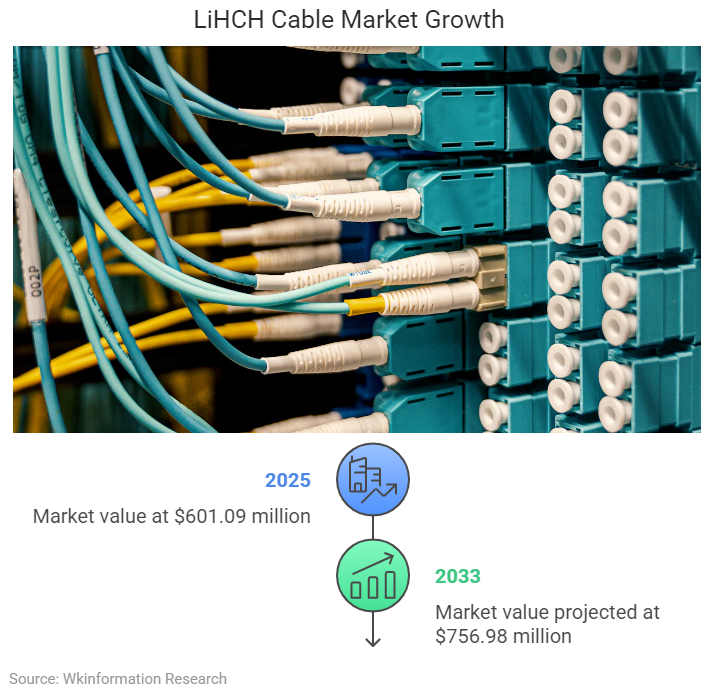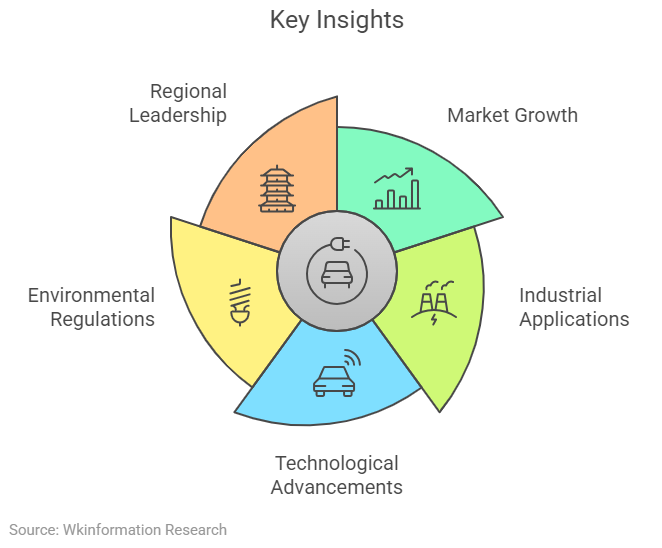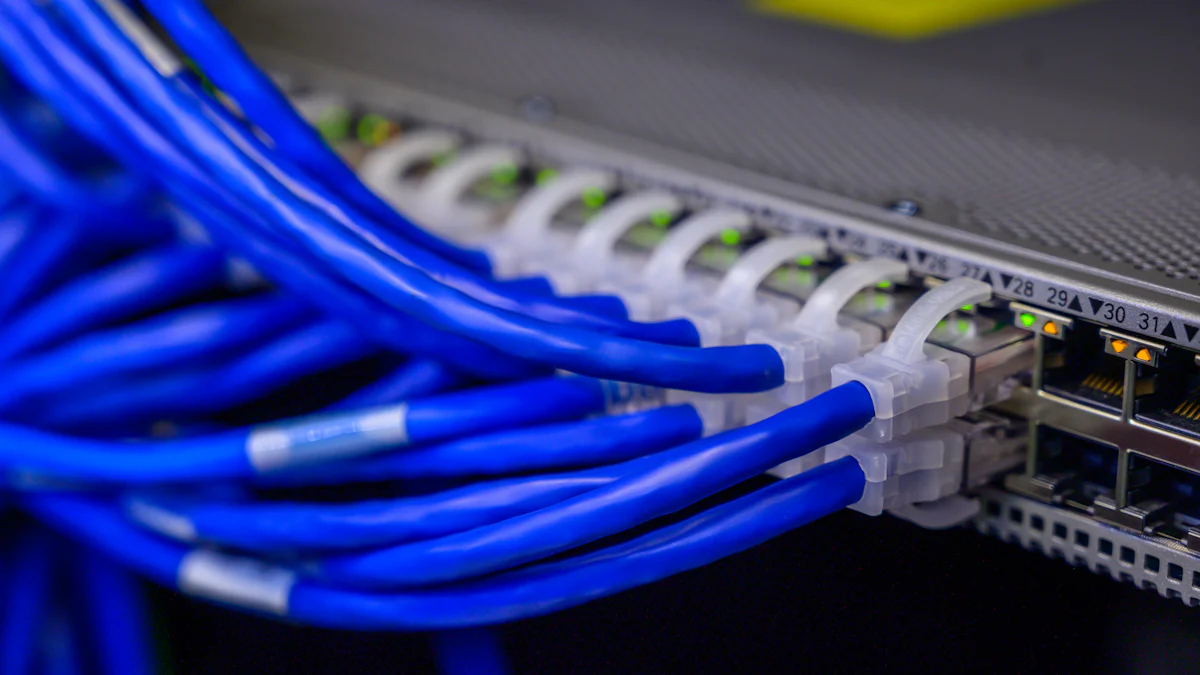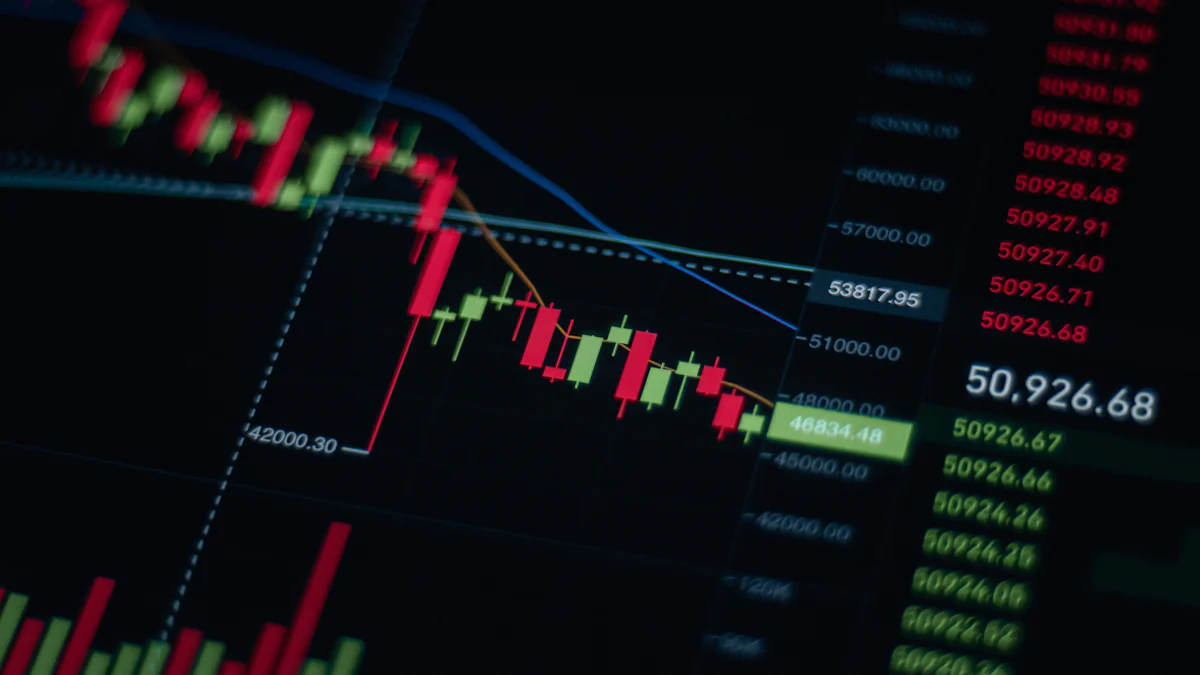
The LiHCH cable market plays a pivotal role in industrial and commercial sectors, offering reliable and efficient solutions for modern electrical systems. Valued at USD 601.09 million in 2025, the market is projected to reach USD 756.98 million by 2033, driven by a compound annual growth rate (CAGR) of 2.92%. This growth reflects increasing demand in electric vehicles and industrial automation. Key advancements, such as eco-friendly materials, lightweight designs, and smart grid technologies, further enhance the market’s relevance in 2025. These factors collectively shape the evolving landscape of the LiHCH cable industry.
Key Insights
- The LiHCH cable market may grow from $601.09 million in 2025 to $756.98 million by 2033. This is due to more use in electric cars and factories.
- LiHCH cables are important for factories and green energy projects. They help send data and power reliably.
- New technology, like smart systems, improves how LiHCH cables work. This makes them great for modern uses.
- Rules for the environment increase the need for safe, recyclable cables. These rules support global eco-friendly goals.
- Areas like Asia-Pacific and North America lead the LiHCH cable market. This is because of factory growth and green energy projects.

Market Overview
Growth Projections
Market size and valuation in 2025
The LiHCH cable market is poised for significant expansion in the coming years. By 2025, the market is expected to achieve a valuation of approximately USD 601.09 million, reflecting robust demand across industrial and commercial sectors. This growth aligns with the increasing adoption of electric vehicles, industrial automation, and renewable energy systems.
The consistent upward trajectory across these estimates underscores the market’s resilience and adaptability to evolving technological demands.
Historical growth trends and their influence on future projections
Historical trends reveal a steady increase in demand for LiHCH cables, driven by advancements in industrial automation and the expansion of the telecommunications sector. The growing need for high-speed data transmission and energy-efficient solutions has further accelerated market growth. These trends provide a strong foundation for future developments, with industries like automotive and renewable energy continuing to drive demand for high-performance cables.
Product Segmentation
By Type: Shielded vs. Unshielded LiHCH cables
LiHCH cables are categorized into shielded and unshielded types. Shielded cables offer superior protection against electromagnetic interference, making them ideal for sensitive applications in industrial automation and telecommunications. Unshielded cables, on the other hand, are cost-effective and suitable for environments with minimal interference.
By Application: Industrial automation, renewable energy, and commercial infrastructure
The demand for LiHCH cables varies across applications. In industrial automation, these cables ensure reliable data transmission and power delivery in complex systems. Renewable energy projects, such as solar and wind farms, require cables with high conductivity and environmental resilience. Commercial infrastructure also relies on LiHCH cables for efficient energy distribution and connectivity.
The wire and cable market continues to evolve, with LiHCH cables playing a pivotal role in meeting the demands of modern industries. Emerging trends, such as the integration of eco-friendly materials and smart technologies, further enhance their relevance.
Key Drivers of the LiHCH Cable Market
Industrial Electrification
Demand for energy-efficient and halogen-free cables
The increasing focus on industrial electrification has significantly boosted the demand for energy-efficient and halogen-free cables. LiHCH cables, known for their low smoke and toxicity levels, align with modern safety and environmental standards. Industries are prioritizing these cables to ensure compliance with stringent regulations while maintaining operational efficiency. Their ability to support high-power electronics, such as inverters and power supplies, makes them indispensable in electrified industrial setups.
Role of automation in driving cable demand
Automation plays a pivotal role in shaping the LiHCH cable market. The adoption of robotics, conveyor systems, and assembly lines in industrial settings has created a growing need for reliable cabling solutions. LiHCH cables facilitate seamless connectivity between programmable logic controllers (PLCs), sensors, and actuators, ensuring smooth data flow. Smart factories, driven by Industry 4.0 technologies, rely on these cables to handle high data rates and complex communication protocols.
Renewable Energy Investments
Expansion of solar and wind energy projects
The rapid expansion of renewable energy projects has fueled the demand for durable and efficient cabling solutions. LiHCH cables are increasingly used to connect solar panels and wind turbines, ensuring reliable power transmission with minimal energy loss. Their high conductivity and environmental resilience make them ideal for long-distance energy distribution in renewable energy systems.
Need for durable and environmentally friendly cabling solutions
Renewable energy systems demand cables that can withstand harsh environmental conditions. LiHCH cables, designed for durability and eco-friendliness, meet these requirements. Their role in renewable energy projects, such as solar farms and wind parks, highlights their importance in achieving global sustainability goals.
Technological Advancements
Innovations in cable materials and design
Technological advancements in the cable industry have enhanced the performance of LiHCH cables. New manufacturing techniques have improved their durability, heat resistance, and flexibility. These innovations make them suitable for tight spaces and extreme conditions, ensuring consistent performance across various applications.
Integration of smart technologies in cable systems
The integration of smart technologies has transformed the cable industry. LiHCH cables now feature smart diagnostics, enabling continuous monitoring of key parameters. Predictive maintenance, powered by machine learning algorithms, optimizes cable lifespan and operational efficiency. These advancements offer benefits such as cost savings, enhanced safety, and support for sustainable practices, aligning with modern cable industry trends.
Challenges in the LiHCH Cable Market
Raw Material Price Volatility
Impact of fluctuating copper and polymer prices
Raw material price volatility poses a significant challenge for the LiHCH cable market. Copper, a primary component in cable manufacturing, experiences frequent price fluctuations. These changes directly impact production costs, creating financial uncertainty for manufacturers. Polymer prices, another critical input, also contribute to market instability. This volatility complicates pricing strategies and affects profit margins. Additionally, intense competition in the industry amplifies the pressure on manufacturers to maintain cost efficiency while delivering high-quality products.
- Fluctuating copper prices increase production costs.
- Market instability arises from unpredictable raw material costs.
- Manufacturers face challenges in balancing innovation with cost control.
Strategies to mitigate cost pressures
To address these challenges, companies adopt several strategies. Many manufacturers diversify their supplier base to reduce dependency on a single source. Others invest in research to develop alternative materials that offer similar performance at lower costs. Long-term contracts with suppliers also help stabilize prices and ensure a steady supply of raw materials. These measures enable manufacturers to navigate price volatility while maintaining competitiveness.
Geopolitical Tensions
Trade restrictions and their effect on supply chains
Geopolitical tensions disrupt global supply chains, affecting the availability of raw materials and finished products. Trade restrictions, such as tariffs and export bans, increase costs and delay production timelines. For the LiHCH cable market, these disruptions hinder the seamless flow of essential components like copper and polymers. Manufacturers must adapt quickly to changing trade policies to minimize operational disruptions.
Regional instability and its impact on production
Regional instability further complicates production processes. Political unrest in key manufacturing hubs can lead to factory shutdowns and labor shortages. These issues reduce output and delay project timelines. Companies operating in unstable regions often face higher insurance costs and logistical challenges, which impact overall profitability.
Environmental Regulations
Compliance with halogen-free and eco-friendly standards
Environmental regulations demand compliance with stringent standards, such as the use of halogen-free materials. These requirements aim to reduce the environmental impact of cable production and disposal. While beneficial for sustainability, compliance increases production costs. Manufacturers must invest in new technologies and processes to meet these standards, which can strain financial resources.
Costs associated with meeting regulatory requirements
Meeting regulatory requirements involves significant expenses. Companies must allocate funds for research, testing, and certification to ensure their products comply with environmental standards. These costs, combined with the need for continuous innovation, create financial challenges. However, compliance also offers opportunities for differentiation, as eco-friendly products attract environmentally conscious customers.
Regional Analysis of the LiHCH Cable Market

Asia-Pacific
Rapid industrialization and urbanization driving demand
The Asia-Pacific region has emerged as a key player in the LiHCH cable market due to rapid industrialization and urbanization. The industrial automation sector is expanding at an unprecedented rate, creating a significant demand for reliable and efficient cabling solutions. LiHCH cables, known for their superior data transmission capabilities, are increasingly being adopted in industrial settings. Advancements in cable technology further enhance their appeal, making them indispensable for modern infrastructure projects. Urbanization also drives the need for robust commercial infrastructure, where these cables play a critical role in ensuring seamless energy distribution and connectivity.
Key countries contributing to growth (e.g., China, India)
China, India, Japan, and South Korea lead the region’s market growth. These countries are characterized by their rapid industrialization and evolving regulatory frameworks. China and India, in particular, are witnessing a surge in demand due to their large-scale infrastructure projects and increasing consumption patterns. Emerging markets in Southeast Asia also contribute to the market’s expansion, driven by rising consumer demand and technological advancements. This regional dynamism underscores the Asia-Pacific’s pivotal role in shaping the global LiHCH cable market.
North America
Investments in renewable energy and smart infrastructure
North America remains a dominant market for LiHCH cables, driven by substantial investments in renewable energy and smart infrastructure. Companies in the region prioritize sustainability, leveraging eco-friendly materials to reduce carbon footprints. The adoption of lightweight and high-performance cables supports the growing demand in electric vehicles and renewable energy projects. Additionally, the shift toward smart grid technologies and energy management systems highlights the region’s commitment to modernizing its infrastructure.
- Companies focus on sustainability, increasing the demand for eco-friendly materials.
- Investments in renewable energy projects continue to rise.
- Smart grid technologies and energy management systems gain traction.
- Lightweight, high-performance cables meet the needs of electric vehicles.
Role of government policies in market expansion
Government policies play a crucial role in fostering market growth. Regulatory frameworks evolve to support technological advancements and sustainable practices. Initiatives promoting industry modernization and international trade partnerships create new opportunities for businesses. Furthermore, investments in research and development drive innovation, enabling the production of eco-friendly and high-performance cabling solutions.
- Supportive policies encourage industry modernization.
- Research and development investments enhance technological advancements.
- Trade partnerships open new business avenues.
Europe
Focus on sustainability and green energy projects
Europe’s emphasis on sustainability significantly influences the LiHCH cable market. The region’s focus on green energy projects, such as wind and solar farms, drives the demand for eco-friendly and energy-efficient cables. Manufacturers innovate to meet stringent regulatory standards and consumer preferences for sustainable solutions. This commitment to sustainability aligns with Europe’s broader environmental goals, positioning the region as a leader in the global market.
- Sustainability efforts increase demand for eco-friendly materials.
- Green energy projects drive market growth.
- Technological advancements cater to consumer preferences for sustainable solutions.
Adoption of advanced cable technologies
Europe also leads in adopting advanced cable technologies. Companies focus on improving product performance while adhering to environmental regulations. Collaboration among industry players fosters innovation, enhancing competition and driving market growth. Despite challenges such as regulatory hurdles, the region continues to thrive by leveraging agile business models and sustainable technologies.
- Advanced technologies improve product performance.
- Collaboration among industry players enhances innovation.
- Agile business models address regulatory challenges effectively.
Emerging Trends in the LiHCH Cable Market

Nearshoring of Manufacturing
Shift towards local production to reduce supply chain risks
The global cable industry is witnessing a shift toward nearshoring as manufacturers aim to mitigate supply chain risks. By relocating production facilities closer to end markets, companies reduce dependency on international logistics and minimize disruptions caused by geopolitical tensions or natural disasters. This approach enhances supply chain resilience and ensures timely delivery of products. For the LiHCH cable market, nearshoring also supports regional economies by creating jobs and fostering local expertise in cable manufacturing.
Impact on regional markets and competition
Nearshoring significantly impacts regional markets by intensifying competition among local manufacturers. Companies investing in advanced production technologies gain a competitive edge, offering high-quality products at reduced costs. This trend encourages innovation and drives the adoption of sustainable practices, as manufacturers prioritize eco-friendly materials to meet regional regulatory standards. The shift toward local production also strengthens regional supply chains, enabling faster responses to market demands.
Environmental Concerns
Growing demand for recyclable and halogen-free cables
Environmental concerns are reshaping the cable industry trends, with increasing demand for recyclable and halogen-free cables. These products align with global sustainability goals by reducing environmental impact during production and disposal. Industries such as renewable energy and electric vehicles prioritize these cables to comply with stringent environmental regulations. Their low toxicity and high safety standards make them a preferred choice for modern applications.
Innovations in sustainable cable production
Manufacturers are introducing innovative solutions to enhance the sustainability of LiHCH cables. These advancements include:
- Low-weight and high-conductivity materials that enhance efficiency.
- Smart cables with embedded sensors for real-time monitoring.
These innovations not only improve the environmental footprint of cable production but also enhance product performance, making them suitable for diverse applications.
Digitalization and Smart Cables
Integration of IoT and smart monitoring systems
The integration of IoT and smart monitoring systems is transforming the LiHCH cable market. These cables now play a crucial role in fostering smarter, interconnected systems across industries. The growing demand for advanced connectivity solutions in sectors like renewable energy and electric vehicles drives this transformation. Smart cables equipped with IoT capabilities enable seamless communication between devices, enhancing operational efficiency and reliability.
Benefits of real-time data tracking in industrial applications
Real-time data tracking through smart cables offers numerous benefits for industrial applications. Continuous monitoring of feeder cables allows for quicker fault detection and repair, reducing downtime and associated costs. Platforms like Smart Cable Guard enable operators to manage power flows, reroute energy, and schedule maintenance without causing outages. This proactive approach minimizes service interruptions and ensures a steady power supply for critical infrastructure. Additional advantages include:
- Reduction in operational repair costs.
- Lower planning expenses.
- Decreased outage penalties.
- Significant return on investment by preventing failures.
These benefits highlight the growing importance of digitalization in the cable industry.
Key Players and Notable Projects in the LiHCH Cable Market
Leading Companies
Overview of major players in the LiHCH cable market
The LiHCH cable market features several prominent players who dominate through innovation and strategic initiatives. Companies such as Belden Inc., Lapp Group, Nexans, Prysmian Group, and Alpha Wire lead the industry. These manufacturers have established themselves as trusted providers of high-performance cabling solutions, catering to diverse industrial and commercial needs. Their extensive global presence and robust distribution networks enable them to meet the growing demand for reliable connectivity across various sectors.
Strategies for growth and innovation
Leading companies employ a range of strategies to maintain their competitive edge. They prioritize research and development to enhance cable performance and durability. This focus on innovation allows them to address the increasing demand for energy-efficient and environmentally friendly solutions. Strategic partnerships with end-users help manufacturers understand specific requirements, enabling the development of customized products. Additionally, investments in advanced manufacturing technologies streamline production processes, ensuring consistent quality and cost efficiency. These approaches position these companies as key contributors to the evolving wire and cable market.
- Belden Inc. emphasizes product development and sustainability.
- Lapp Group invests in R&D to create advanced cable designs.
- Nexans collaborates with renewable energy firms to expand its market share.
- Prysmian Group focuses on smart cable technologies and eco-friendly materials.
- Alpha Wire targets niche markets with specialized cabling solutions.
Notable Projects
High-profile renewable energy and industrial projects
LiHCH cables play a critical role in several high-profile projects worldwide. Renewable energy initiatives, such as offshore wind farms in Europe and solar parks in North America, rely on these cables for efficient power transmission. Industrial automation projects in Asia-Pacific also showcase the importance of LiHCH cables in ensuring seamless communication between machinery and control systems. These projects highlight the versatility and reliability of these cables in demanding environments.
Case studies showcasing the use of LiHCH cables
One notable example is the integration of LiHCH cables in a large-scale wind energy project in Germany. The cables provided exceptional durability and resistance to harsh weather conditions, ensuring uninterrupted power transmission. Another case involves their use in a smart factory in Japan, where the cables supported high-speed data transfer between automated systems, enhancing operational efficiency. These case studies demonstrate the adaptability of LiHCH cables in diverse applications, reinforcing their value in modern infrastructure development.
Overview
The LiHCH cable market continues to evolve, driven by industrial electrification, renewable energy investments, and technological advancements. Challenges such as raw material price volatility and environmental regulations shape the competitive landscape, while regional developments in Asia-Pacific, North America, and Europe highlight diverse growth opportunities. Emerging cable industry trends, including nearshoring and digitalization, underscore the market’s potential for innovation and sustainability. Stakeholders can leverage these trends to address global demands for efficient, eco-friendly solutions, ensuring long-term success in this dynamic sector.
| Report Metric | Details |
|---|---|
| Report Name | Global Lihch Cable Market Report |
| Base Year | 2024 |
| Segment by Type | · Shielded LiHCH Cables
· Unshielded LiHCH Cables |
| Segment by Application | · Industrial Automation
· Renewable Energy · Commercial Infrastructure |
| Geographies Covered | · North America (United States, Canada)
· Europe (Germany, France, UK, Italy, Russia) · Asia-Pacific (China, Japan, South Korea, Taiwan) · Southeast Asia (India) · Latin America (Mexico, Brazil) |
| Forecast units | USD million in value |
| Report coverage | Revenue and volume forecast, company share, competitive landscape, growth factors and trends |
FAQ
What are LiHCH cables, and where are they used?
LiHCH cables are low-capacitance, halogen-free control cables with shielding for electromagnetic interference protection. They are widely used in industrial automation, renewable energy systems, and commercial infrastructure for reliable data transmission and power delivery.
Why are halogen-free cables important in modern industries?
Halogen-free cables reduce toxic emissions during fires, ensuring safety and environmental compliance. Their low smoke production minimizes damage to sensitive equipment, making them essential for industries prioritizing safety and sustainability.
How do technological advancements impact the LiHCH cable market?
Innovations in materials and smart technologies enhance cable performance, durability, and efficiency. Features like IoT integration and real-time monitoring improve operational reliability, aligning with modern industrial and energy demands.
What challenges do manufacturers face in the LiHCH cable market?
Manufacturers encounter raw material price volatility, geopolitical tensions, and stringent environmental regulations. These factors increase production costs and complicate supply chains, requiring strategic planning and innovation to maintain competitiveness.
Which regions dominate the LiHCH cable market?
Asia-Pacific, North America, and Europe lead the market. Asia-Pacific benefits from rapid industrialization, North America focuses on renewable energy, and Europe emphasizes sustainability and advanced technologies.
Global Lihch Cable Market Report – Table of Contents
1 Market Study Overview
2 Basic Product Information
3 Market Analysis
4 Lihch Cable Related Market Analysis
5 Global Trend Summary
6 Competition by Manufacturer
7 Analysis of Key Players
8 Global Lihch Cable Revenue, Sales Categorized by Regions
9 North America Lihch Cable Market Size Categorized by Countries
10 Europe Lihch Cable Market Size Categorized by Countries
11 Asia-pacific Lihch Cable Market Size Categorized by Countries
12 South America Lihch Cable Market Size Categorized by Countries
13 Middle East and Africa Lihch Cable Market Size Categorized by Countries
14 Global Lihch Cable Industry Segment Analysis
15 Global Lihch Cable Market Forecast
16 Research Findings and Conclusion
17 Appendix


